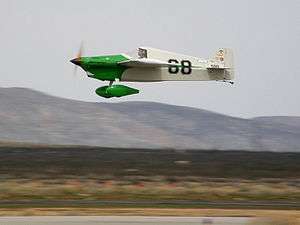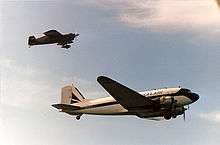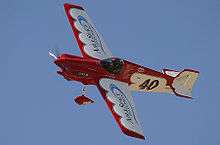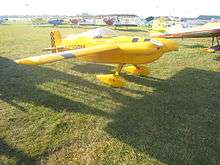Cassutt Special
| Cassutt Special | |
|---|---|
 | |
| Role | Formula 1 racing aircraft |
| Manufacturer | Homebuilt |
| Designer | Tom Cassutt |
| First flight | 1954 |
| Unit cost |
approximately $2020 to build in 1971[1] |



The Cassutt Special is a tiny single-seat racing aircraft designed in the United States in 1951 for Formula One air races and still available for homebuilding. Designed by ex-TWA captain Tom Cassutt, it is a mid-wing cantilever monoplane with fixed tailwheel undercarriage. The fuselage and tail are of fabric-covered steel tube construction, and the wings are built from plywood over wooden ribs.[2] An updated taper-wing design was first flown in 1971 on Jim Wilson's "Plum Crazy".[3]
Plans and parts are available from Creighton King of Salt Lake City, Utah, United States, for amateur construction. King also offers plans for the Stockbarger tapered wood wing.[4][5]
Design and development
The aircraft is built with a 4130 tubular steel spaceframe fuselage and a plywood-skinned wing with solid spruce spar and built-up ribs. The design lends itself well to modification, there being several different wing options of wood or composite construction.[5]
The standard engine used for competition is the 100 hp (75 kW) Continental O-200, while other, lower-powered engines can be used for recreational flying, including the 65 hp (48 kW) Continental A65 and the 60 hp (45 kW) Volkswagen air-cooled engine.[5]
Operational history
- 1958 - Tom Cassutt flies his Cassutt to win the National Championship Midget Air Races at Ft. Wayne, Indiana.[6]
Variants
- Cassutt I
- Developed in 1951, First race at Dansville, New York in 1954.
- Cassutt II
- Casutt IIM
- 13.67 ft (4.2 m) wingspan
- Cassutt III
- 15 ft (4.6 m) wingspan
- Cassutt IIIM
- 17.00 ft (5.2 m) wingspan[7]
Specifications (Cassutt III racer)
General characteristics
- Crew: One pilot
- Length: 16 ft 0 in (4.88 m)
- Wingspan: 15 ft 0 in (4.57 m)
- Height: 4 ft 0 in (1.22 m)
- Wing area: 68 ft2 (6.3 m2)
- Empty weight: 500 lb (227 kg)
- Gross weight: 850 lb (386 kg)
- Powerplant: 1 × Continental O-200, 100 hp (65 kW)
Performance
- Maximum speed: 248 mph (400 km/h)
- Range: 450 miles (725 km)
- Rate of climb: 1,500 ft/min (7.6 m/s)
See also
Aircraft of comparable role, configuration and era
References
| Wikimedia Commons has media related to Cassutt Racer. |
- ↑ Leo J. Kohn (Winter 1971). "The true cost of building your own plane". Air Trails: 63.
- ↑ "What kind of aircraft would you build?". Air Progress Sport Aircraft: 49. Winter 1969.
- ↑ Air Progress: 12. November 1971. Missing or empty
|title=(help) - ↑ Bayerl, Robby; Martin Berkemeier; et al: World Directory of Leisure Aviation 2011-12, page 113. WDLA UK, Lancaster UK, 2011. ISSN 1368-485X
- 1 2 3 Tacke, Willi; Marino Boric; et al: World Directory of Light Aviation 2015-16, page 119. Flying Pages Europe SARL, 2015. ISSN 1368-485X
- ↑ Sport Aviation. November 1958. Missing or empty
|title=(help) - ↑ Purdy, Don: AeroCrafter - Homebuilt Aircraft Sourcebook, Fifth Edition, page 213. BAI Communications, 15 July 1998. ISBN 0-9636409-4-1
- Taylor, Michael J. H. (1989). Jane's Encyclopedia of Aviation. London: Studio Editions. p. 239.
- Manufacturer's website
- Owners's Forum